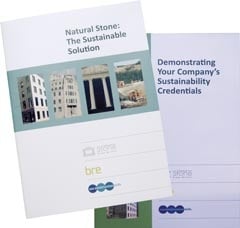Sustainability: An opportunity not a threat
One of the benefits of belonging to Stone Federation Great Britain is that it can mobilise help for its members on confusing and rapidly developing subjects such as sustainability, as well as promoting stone as a sustainable material.
It helped stone companies understand the concepts of sustainability last year by organising two seminars on the subject funded by ConstructionSkills and presented by BRE. One was at the BRE in Garston, Hertfordshire, and the other in York.
Presentations were given by Mike Jaggs and Flavie Lowres, both Senior Consultants with BRE. As well as the presentations they also produced a 36page document, Natural Stone: The Sustainable Solution, summarising the information they had presented at the seminars, and a companion document called Demonstrating Your Company’s Sustainability Credentials. They are a useful introduction to sustainability and are available (as hard copies only) from Stone Federation Great Britain (see inside the back cover of this magazine for the Stone Federation’s address and contact details).
As Mike Jaggs began by saying at the seminars, sustainability is a huge subject that just gets bigger and more complex the more you look into it.
However, it can be boiled down to three pillars known as ‘the triple bottom line’: environmental, social and economic. When all three are considered equally, development might be said to be sustainable.
The reason sustainability is such a big deal for construction is because buildings account for about 60% of the world’s CO2 emmissions, one way and another.
Most of the CO2 is the reult of heating, cooling and lighting buildings when they are being used (hence moves like the Green Deal* that comes fully into force this month when finance plans for the scheme are announced on the 28th) but about 16% of it is the result of their construction.
Much of the CO2 involved in construction comes from making the cement so widely used in concrete and concrete products – and concrete is said to be mankind’s third most consumed product after water and petrol.
Making buildings carbon neutral is supposed to become a legal requirement, but the Government has been steadily watering down its proposals – so much so, in fact, that Building magazine is now running a campaign to try to get the Coalition to change its collective mind and return to the green agenda.
Announcing the magazine’s Green for Growth campaign, Sarah Richardson, Editor of Building, wrote this month: “David Cameron’s husky-hugging pledge to deliver the greenest ever Government may be his most discredited pre-election promise.
“Despite the Climate Change Act target of reducing carbon emissions by 34% by 2020, a series of policy U-turns and the watering down of environmental ambitions have signalled dangerous backpeddling on the green agenda.
“This is bad news for two reasons. As scientific evidence shows ever swifter and more worrying effects of climate change, the need to find a more environmentally sustainable way to live is more urgent than ever.
“And, of more day-to-day concern to a construction industry in deep recession, is the fear that the government is squandering opportunities for work that green growth could offer.
“The Confederation of British Industry says that the ‘green market’ (not all of which is related to construction) accounts for £122billion, or 8% of GDP, and may have provided a third of all growth in the economy in 2011/12.
“Building is therefore launching a Green for Growth campaign. We are calling for the Government to stimulate investment in green building as a way both to safeguard the UK’s environmental future and help generate growth in the construction industry.”
Sarah Richardson says the campaign will focus on five key areas: the Green Deal; ringfenced spending for public sector retrofit programmes; zero-carbon housing; Display Energy Certificates; clarity around long-term energy infrastructure investment.
She continues: “The Government’s lack of leadership on these issues has led the industry to stall on investment in the skills that this new economy will need. But Building believes if the coalition puts sustainability firmly back on its agenda and reconsiders its most damaging decisions, the construction sector can play a crucial role in tackling global warming, developing expertise that will be in growing demand the world over.”
She calls on readers to go to building.co.uk/greenforgrowth to add their support to the campaign. “Together we can protect construction jobs while helping to save the planet,” she says.
Her call for action came just days before the latest figures from the Office for National Statistics showed another hefty fall in construction output. In the three months to November new build decreased by 11.2% and repair & maintenance by 5%. Private commercial work, the largest sector of construction, contracted by a further 16.2%.

